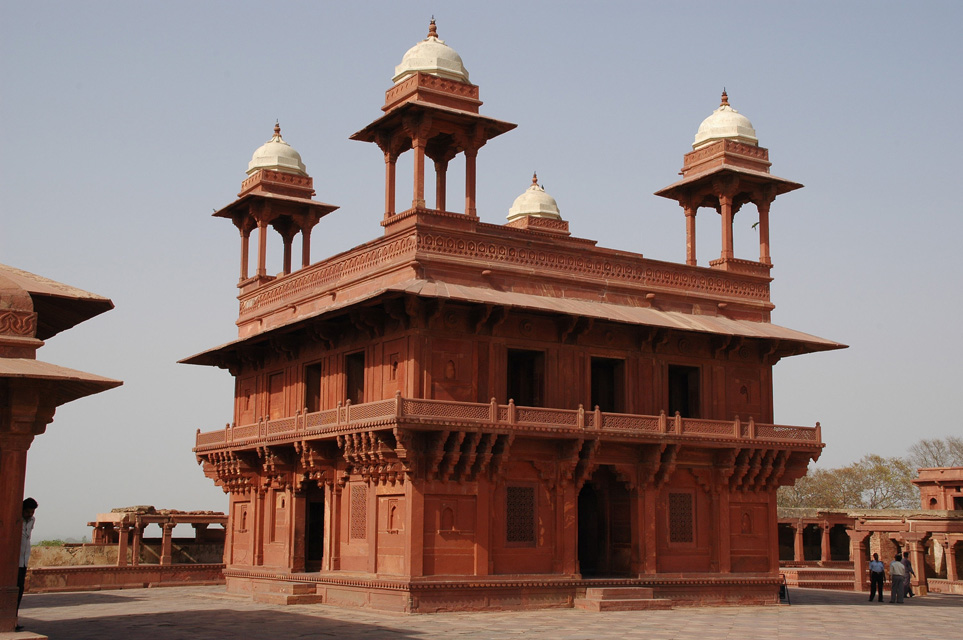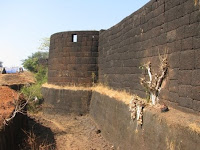Thursday, May 31, 2012
Anjanwale Fort
Tadoba National Park
| Tadoba National Park | |||
| |||
| | |||
| Spread over 120 sq km, the Tadoba National Park is the oldest national park in Maharashtra and comes under the Project Tiger umbrella. It is located 100 km south of Nagpur and 45 km north of Chandrapur. The National Park is named after Tadoba, a courageous village chief who died while valiantly fighting off a tiger. Thickly forested hills form the north and western boundaries of the Tiger Reserve. To the southwest is the huge Tadoba lake, which acts as buffer in between the Park Forest and the extensive farmland extending right up to the Irai Lake. The national park is a haven for wildlife enthusiasts and nature lovers and is aptly called 'The Jewel of Vidarbha'. The rich deciduous forests of the reserve are blessed with a rich and varied flora and fauna. The main attraction of the Park is its jungle safari. A 12-seater minibus takes visitors around the Park. Keep a look out for the denizens of the Park that include more than thousand species of birds, animals, insects and other life forms. You will see large herds of Chitals, Sambars, Barking Deer, Chausingha and Neel Gai as you drive by. You would be lucky to spot a sloth bear, wild dog, wild boar and leopard who are other inhabitants of this beautiful wildlife sanctuary. Ornithologists will get to see as many as 181 species of birds, including water birds. The greatest attraction here is undisputedly the majestic tiger. It continues to enamor tourists of all age groups and interests. As the night falls the jungle air comes alive with the sounds of civets and squirrels. Head out to the large bamboo fringed Tadoba Lake. It is the home of the marsh crocodile and attracts many water birds like Cattle Egrets, Purple Moorhens and Jacanas. A motorable road runs along the perimeter of the lake and makes an excellent walker's track. The rich, dry deciduous forests are full of enchanting jungle trails. Experienced trekking guides are available to take tourists to the different points of interest. Wild life viewing has been made all the more easier with the help of observation towers and 'machaans' where animals are sighted especially at dusk. The best time to visit the park is in the cool months of November to February when the weather is very pleasant and humidity is at its lowest. There are good facilities for overnight stay at the park at the three forest rest houses located around the lake. | |||
Peshwa memorial
| ||||||||||
| ||||||||||
| | ||||||||||
| One of the yet untouched jewels of the long Konkan coastline is Shriwardhan, which boasts of a beautiful beach. The adventurous can take a boat and explore the north side of the Bay where the erstwhile Peshwas of the Maratha regime once lived and took important decisions with historic ramifications. The Peshwa Smarak is a memorial to the Peshwas, the Prime ministers of the Maratha kingdom who originally resided here. |
Bankot Fort
Bankot Fort | ||||||||||
| ||||||||||
| | ||||||||||
| One of the less explored jewels of the long Konkan coastline is the lovely Shriwardhan bay. The beach is a popular tourist attraction and if you love seafood, you must try some of the delicious local fare here. The Bankot Fort is one of the principal attractions of the area and is situated at Bagmandala, at a distance of 4 kms from the town. The adventurous can hire a boat and explore the north side of the bay where the Peshwas of the Maratha kingdom originally resided. |
Sajja Kothi
Sajja Kothi | ||||||||||
| ||||||||||
| | ||||||||||
| If you are interested in a bit of intrigue, visit the Sajja Kothi and listen to the story of how the Brave Warrior King Chhatrapati Shivaji made his escape from the Jaws of Death! Situated amidst lush greenery, the majestic Sajja Kothi offers a gorgeous view of the Waranna valley below. Sajja Kothi is a three-storied building built by the Mohammedans in 1008 AD. The building, which was actually a punishment cell, is a classic example of Mughal architecture. The chambers of the building are mute testimony to many a tragic tale. When you visit the fort, you will hear a very interesting anecdote associated with the monument. It is said that when Siddi Johar, a formidable Bijapur General attacked Panhala, Shivaji tricked the general by escaping from the window of Sajja Kothi while a brave soldier Shiva Kashid disguised himself as Shivaji and combated the fury of the general. It is the same place where Sambhaji was imprisoned by treacherous means. He plunged down into the deep valley and made his escape. | ||||||||||
Ambarkhana Fort
| Ambarkhana Fort | |||
| | |||
| | |||
| While at Panhala you must visit Ambarkhana. Built by the Marathas, Ambarkhana Fort housed the administrative division as well as an elegant palace, the Mint, and the granaries for the armies. Since the soil on the ranges was laterite and thus unsuitable for cultivation, provisions had to be stockpiled. The ancient building also known as the "Dhanyancha Kothar" was designed to store large quantities of food grains. Titled Ganga, Jamuna, and Saraswati, the granaries could store as much as 25,000 khandis of grain. However, the focus point of this fort is its spectacular Teen Darwaja or the Three Gates that provide |
Karnala Fort
| Karnala Fort | ||||||||||
| ||||||||||
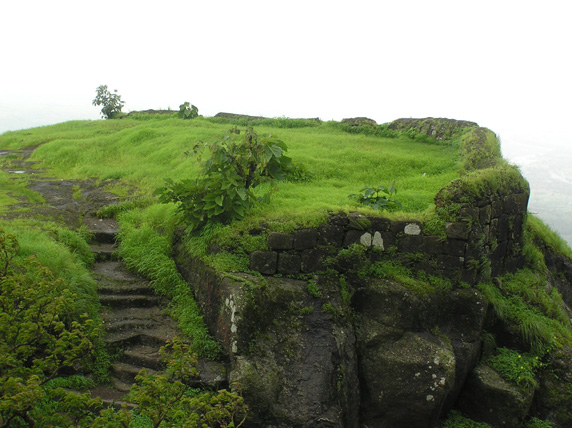 | ||||||||||
| At a distance of about 55 kilometres away from Mumbai, in the town of Karnala, stands the famous Karnala Fort, also known as the'Funnel Hill'. Dating back to the 12th Century, the Karnala Fort was under the Nizamshahi rule until the 15th century, after which Emperor Shivaji captured it by building obstructions all around the fort. The Mughals, the Angres and the Peshwas were some of its later conquerors and eventually, Colonel Prother of the British Empire finally captured the Fort in 1818. Situated on Mumbai-Goa Highway, between Panvel and Pen, the Fort is surrounded by dense forest, with various species of plants, birds and animals openly visible here. Remains of the gates and godowns of the Fort still exist and are viewable by travellers visiting the Karnala Fort. On a clear and sunny morning, from a beautiful vantage point at the Fort, one is afforded an eagle's eye view of the surrounding areas. On any clear day, the Mumbai coastline, 30 KM away, is totally noticeable from the crest of the Fort. The Fort, with its steep rocks, has always challenged trekkers and especially in the monsoons, the path leading to the summit of the fort is permanently adorned in strands of mist and cloud, forming both a challenging track for trekkers, as well as, a beautifully elevating experience. The Fort is also known for its small Bhavani Temple at the peak which is surrounded by rock-cut caves and water tanks built by the Buddhists. A major tourist hub, the Karnala Fort should definitely feature at the very top of your travel itinerary! |
Karnala Bird Sanctuary
| Karnala Bird Sanctuary | ||||||||||
| ||||||||||
 | ||||||||||
| The Karnala Bird Sanctuary, which is around 25 m above sea level, lies at the bottom of the Karnala Fort and is located some 10 km off the Mumbai-Pune Highway. The Karnala Bird Sanctuary is quite small with an area of 4.27 sq. kilometres but is one of the few sanctuaries other than the Sanjay Gandhi National Park to be within reach of Mumbai city. Home to over 147 species of resident and 37 species of migratory birds who visit the sanctuary during winter, the Karnala Bird Sanctuary is one of the most comprehensive reserves in the country. Two rare birds, the Ashy Minivet and the Malabar Trogon, are claimed to have been sighted here. At the sanctuary, there are essentially two separate seasons for bird watching. In the monsoons, one can see the Paradise Flycatcher, Magpie, Robin, and the Malabar Whistling Thrush, which are among some of the most melodious avian singers. Arrays of other birds like the Racket-Tailed Drongo, Horn Bill, Red Vented Bulbul, Owl, Myna and the Ashy Rain War Blur have been sighted here. During winters, many species of migrant birds like Throat, Shrike, Blue and Large Cuckoo are seen, among others. While the Karnala Bird Sanctuary is chiefly known for its birds, sometimes one may also spot sntelopes, panthers, langurs and African monkeys. The Sanctuary is also known for the variety of trees found her; Asana, Kalam, Koshimb, Kalam, Mango, Teak and Umbar are seen at the top canopy. The Karnala Bird Sanctuary is one of the more popular destinations for avid bird-watchers and hikers in the Mumbai area. Even a simple walk through the forests is enough for travellers to forget their cares. A great getaway, the Karnala Bird Sanctuary is definitely worth making a halt at. | ||||||||||
Radhanagari Dam
| Radhanagari Dam | ||||||||||
| ||||||||||
 | ||||||||||
| The Radhanagari Dam, located in the Kolhapur District of Maharashtra, was constructed by Shahu Maharaj, the ruler of the Kolhapur State. Built across the Bhagawati River, this century old dam is used mainly for the important purposes of irrigation and hydroelectric power generation. The dam is 1037 m long, covering about 11,000 hectares of wooded hills that surround the Radhanagiri Dam. There is also a hydroelectric project with an installed capacity of 10 MW. The dam is located at a scenic spot, with a stunningly spectacular backdrop of thick forest covers. The dam site is a habitat for many birds and varied flora. Visitors flock here in large numbers each year to the see the spectacular bird species that grace the area around the Radhanagiri Dam. As a part of the promotion of Maharashtra tourism, the Radhanagiri Damn climbed the popularity chart and emerged as quite a favourite with locals, as well as tourists. Head here for some peace, solace and nature at its stupendous best! One thing is for certain, you won't be disappointed. It is just the location for the peace and quiet that one looks for while taking a relaxing break from the mundane routine of life. | ||||||||||
Shinde Wadi Hills
| Shinde Wadi Hills | ||||||||||
| ||||||||||
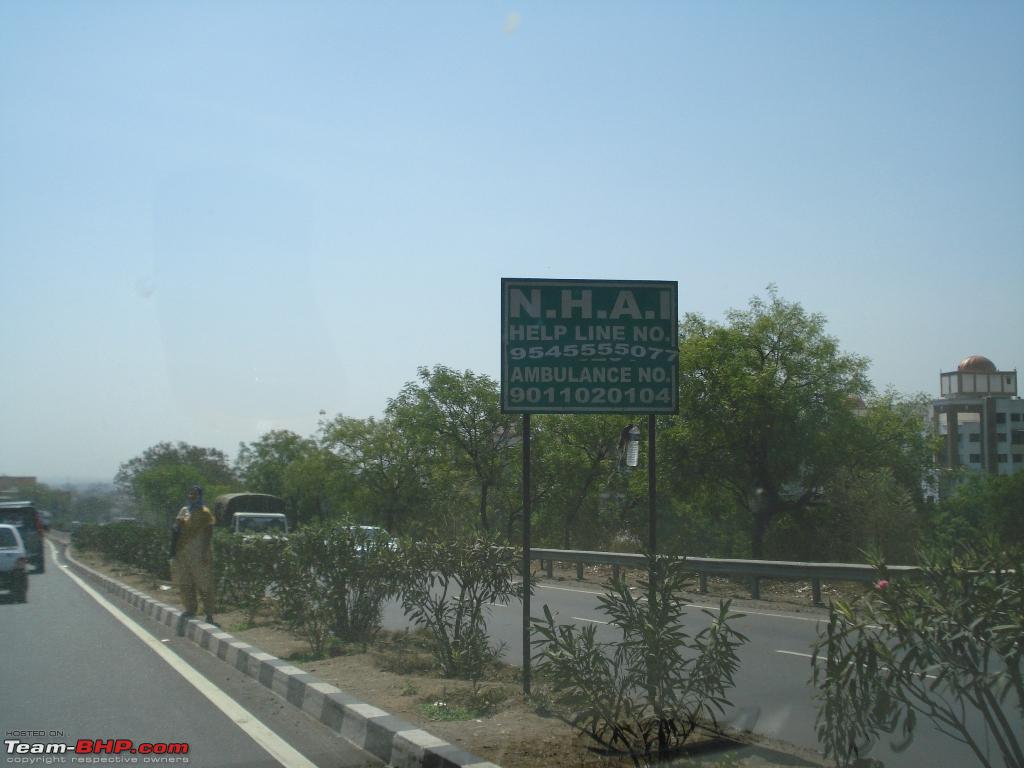 | ||||||||||
| The Shinde Wadi Hills is located at a distance of around 2 km from the small town of Kamshet. Luscious, fresh and a huge haunt for picnics, the locals love the freshness and revitalizing essence of the Shinde Wadi Hills. Historically, this destination holds significant importance. It is strongly rumoured that in a battle between the British and the Marathas, this was the place from where Madhavrao Shinde's soldiers fired a cannon from the top of the hill to stop the advancing British Battalion and ended up blowing off the head of the leader of the advancing British Battalion. Another fascinating feature of these Hills is that it is a major hub for paragliding, with both professionals and amateurs flocking here to try their hand at this adventure sport. The gentle sloping hill is especially famous amongst the trainees of paragliding and is ideal for beginners in particular. Whether you’re looking to check off ‘paraglide’ from the list of things you must do or if you’re just looking to get lost in the serenity and solitude of the hills, the Shinde Wadi Hills will exceed all your expectations and leaving you wanting to return. | ||||||||||
Pavana Lake
| Pavana Lake | ||||||||||
| ||||||||||
| | ||||||||||
| Pavana Lake is essentially an artificial lake brought into existence due to the Pavana Dam. A picturesque sight, the Pavana Lake, along with the Pavana Dam, is located around 14 kilometres away from Lonavla. Offering much-needed solitude and some peace and quiet, the Pavana Lake is not a crowded place like Lonavala. Tucked away around 19 kilometres somewhere inside Kamshet, the Pavana Lake offers a soothing outing for the tired city soul. A tiny getaway in Kamshet, Pavana Lake is fast gaining popularity among the locals, most of who are looking for a quiet weekend getaway, with friends and family. A popular picnic spot, the areas around the Lake and the Dam can often be seen teeming with families out on a pleasantly sunny morning, enjoying the view and munching on the loot in the picnic basket. If you’re looking to go beyond the Pavana Lake and wish to explore the areas in and around there, you will find the forts of Lohgad, Tikona and Tungi ostensibly visible from the Lake. Make your way tol either of the forts and enjoy a piece from our country’s history, set against the backdrop of the lush Pavana Lake and the areas around it. While locals flock to this area at any time of the year, most of the tourists from the other parts of the country usually visit during the months of monsoon or immediately after. Set up an itinerary that includes a trip to the Pavana Lake and you’re sure to never regret it! |
Wednesday, May 30, 2012
Karla, Bhaja and Bhedsa Caves
| Karla, Bhaja and Bhedsa Caves | ||||||||||
| ||||||||||
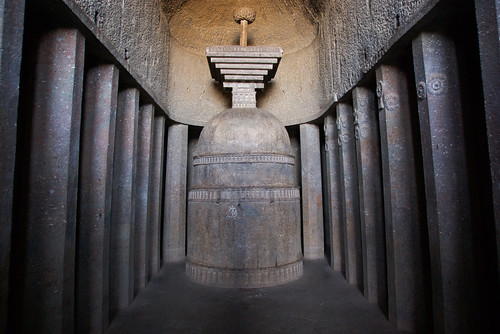 | ||||||||||
| The Karla, Bhaja and Bhedsa Cave temples are perfect examples of the early phase of Buddhist architecture known as the Hinayana phase, wherein, the Buddha was represented symbolically. The characteristic features of these early temples were two establishments, each self-contained and consisting of a prayer hall (chaitya) and a monastery (vihara), which contained accommodation for the monks. The square central hall was approached through a verandah or portico and doorways led into cells for members of the brotherhood. The Karla Caves were carved somewhere around the 2nd Century BC, the time when Buddhism was at its peak in India. One of the main structures situated inside the Karla Caves is that of a Chaitya Hall (prayer hall), which has been adorned with exquisitely carved sculptures. Adding to the beauty of the Chaitya Hall is a number of pillars, with splendid and awe-inspiring structural designs. The roof, constructed out of teakwood, serves as the perfect testimony to the excellent carving skills of the artisans of those times. The Bhaja Caves, near the Karla Caves, are a group of 18 rock-cut caves dating back to 200 BC. Viharas make up ten caves and one is a chaitya, stylistically similar to the Karla Caves. There is also group of 14 stupas, five inside and nine outside the caves. Near the last cave is a waterfall, which, during the monsoon season, has water that falls into a small pool at the bottom. The Bhaja Caves are perfect examples of the phase of early Buddhist architecture, belonging to the early Theravadin period. The Bhedsa Caves belong to a slightly later period than the Bhaja Caves. The Chaitya resembles the Rear Hall at Karla but is smaller. It has four pillars, each 25 feet high, with carvings of horses, bulls and elephants mounted by male and female riders. 26 octagonal pillars, at a height of about 10 feet, support its ribbed roof. All three caves, though of Buddhist origin, show different stages in the evolution of Buddhist architecture. Unique in its depiction, do visit the caves for a visual illustration of the changes in the history of Buddhist architecture. |
Tribal Museum
| Tribal Museum | ||||||||||
| ||||||||||
 | ||||||||||
| One of the unique places in Pune is the Tribal Museum that showcases the cultural life of the people of Maharashtra. It is managed by the Tribal Research and Training Institute. On display are handicrafts, paintings, artifacts, weapons, musical instruments that were used by the Marai tribes, Wagdheo tribes Danteswari tribes and Bahiram tribes belonging to the Sahyadri ranges. It is open 10.30 pm- 5.30 pm on all days except Government holidays. | ||||||||||
St. Mary’s Church | ||||||||||
| ||||||||||
| | ||||||||||
| Another site of religious and sightseeing attraction is the St. Mary’s Church. This beautiful Victorian era church was constructed in 1825 for the worship requirements of the British residents in Pune. The mortal remains of Sir Robert Grant a writer and former Governor of Bombay were placed beneath the church floors. The pipe organs used in the Church is an original piece dating back to 130 years ago. | ||||||||||
Panshet Water Park
| Panshet Water Park | ||||||||||
| ||||||||||
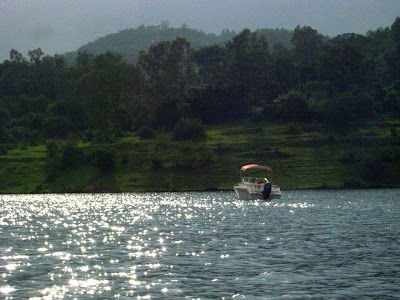 | ||||||||||
| The Panshet Water Park is full of water adventure sports activities for both locals and tourists to enjoy a full day of fun filled activities. It is situated between Panshet dam and Varasgaon Dam. This attractive water park offers a variety of activities such as swimming, kayaking, wind surfing and rides on the speed boats. Other close by attractions include Khadakwasla Dam, Raigad Fort and Sinhagad Fort. |
Mahatma Phule Vastu Sangrahalaya
Mahatma Phule Vastu Sangrahalaya | ||||||||||
| ||||||||||
| | ||||||||||
| The interesting Mahatma Phule Vastu Sangrahalaya, which was earlier known Mahatma Phule Museum, was established in 1875 AD. It showcases a multitude of marble statues, brassware, arms, jewelry, textile products and many items related to industry, geology and agriculture. There is a library that is well stocked with a rare collection of books. There are numerous seminars and film shows for those interested in knowledge exchange. The museum is open on all days except Wednesday from 8 am to 5 pm. | ||||||||||
Lord Ayyappa Temple
| Lord Ayyappa Temple | ||||||||||
| ||||||||||
 | ||||||||||
| Another temple dedicated in the memory of Lord Ayyappa Temple in Dehu is a pilgrimage center. It is full of devotes at the Mandala festival between December 16 to January 15. |
Katraj Snake Park
| Katraj Snake Park | ||||||||||
| ||||||||||
| | ||||||||||
| The Katraj Snake Park was established in 1986 and is located on the Pune–Satara Highway at Katraj. It houses rare species of snakes and other reptiles, birds and turtles. You can actually see the rare Brown Palm Civet and is known to be the only one in captivity in India. Another attraction is the 9 feet Black King Cobra that was found in the Sunder bans. The Snake Park is open on all days from 10 to 5 pm. | ||||||||||
Dehu temple
| Dehu temple | ||||||||||
| ||||||||||
 | ||||||||||
| The place of birth of the poet saint Tukaram, Dehu is an ancient city situated at the banks of the River Indravati. Tukaram is one of the most inspiring poets of ancient Maharashtra and is known for his exemplary work- Abhang Gatha’. One of the most prominent places is the Dehu temple constructed in the 18th century by the poet’s youngest son. It is dedicated to Lord Pandurang. Other attractions here include the rock formation that came into being by a standing fast undertaken by Tukarama and a well landscaped garden dedicated in his wife’s memory. | ||||||||||

